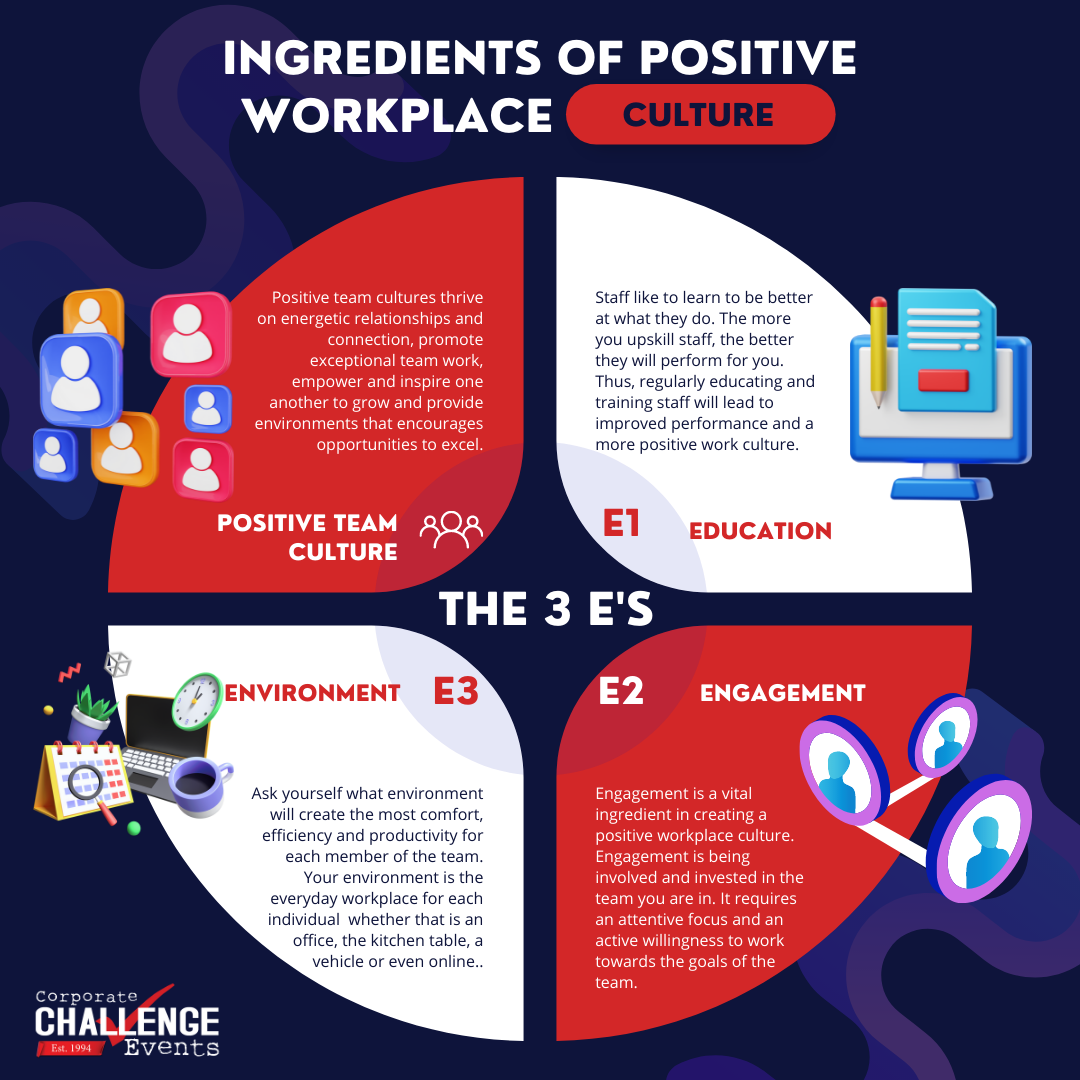You know when you walk into a workplace and it has a certain buzz in the air? You don’t know exactly what it is, but the team is happy and upbeat, people are smiling and genuinely look like they want to be there.
But what is it that makes a workplace have this aura about them? And what is it about this that attracts employees and makes them never want to leave? It’s a positive team culture of course!
A positive team culture in 2023 is about people first. Taking a people first approach means actively creating a desirable work environment that takes into account, and aims to fulfill the needs of one of your most important assets: your people.
So, what are employees really looking for these days? While a competitive salary may have attracted potential employees in the past, now it’s more about the actual job itself. More specifically, it’s about being part of a cohesive team, as well as the ability to balance work with everyday life.
According to Kris Boesch, founder and CEO of Choose People, studies show that culture-driven organisations experience a number of key workplace culture benefits, when compared to businesses that don’t have a people first culture. Some of these include 26 per cent fewer mistakes, 22 per cent higher productivity, 41 per cent lower absenteeism, and 30 per cent stronger customer satisfaction.
Leaders who focus on their team’s development and well-being create an environment that supports employee growth. This, in turn, results in higher levels of engagement and motivation, which leads to better business outcomes.
Lets break that down a bit more… to adopt a positive team culture you must focus on development and well-being (education) and create an environment to support this. When combined these two key focus areas, it will lead to greater engagement which ultimately leads to a thriving team culture.
If you have read any of my articles before then you will know that I am an advocate for the 3 E’s…
I believe in order to enjoy the benefits of a positive team culture you must first master the art of…
EDUCATION
ENGAGEMENT
ENVIRONMENT
In this article we discuss each E and highlight some significant statistics that supports the 3’Es framework.

Education
As businesses move towards more sophisticated career paths in the next couple of years, it is becoming increasingly evident that the emphasis placed on education initiatives can have a large impact on employee well-being and job satisfaction. While traditional notions may point to tangible rewards like promotions, salary and challenge as key motivators for employees to stay at an organisation, modern professionals also understand the benefits education in the workplace provides. With mindsets rapidly shifting from seeing professional and personal development programs as ‘nice-to-haves’ to must-haves, there is a growing belief among industry professionals and scholars that quality education in the workplace should be a core pillar for businesses aiming for success.
Education in the workplace can take many forms, such as providing access to human skills courses, creating formal mentorship programs for new hires or apprentices, offering team workshops , or aligning your team with your organisations why. Regardless of which methods you choose to implement, giving your employees opportunities to learn new skills can be beneficial both in boosting morale and performance—and the bottom line! See our latest article on L&D in 2023.
- N80% of employees said learning and development opportunities would help them feel more engaged on the job.
- N76% of employees agree that they are more likely to stay with a company that offers continuous training
- NAccording to employees, companies can make training more effective by aligning training with job responsibilities, updating training content more frequently, and making training more social
- N84% of employees are somewhat or extremely concerned that ‘reluctance by managers to encourage new ways of learning and working’ are holding L&D teams back.
- NCompanies that invest in training have a 24% higher profit margin.
- NLearning and training at a workplace are important to 87% of millennials.
Engagement
Employee engagement is essential for creating a motivated and productive workplace. When employees are engaged and invested in the team, they are more likely to take ownership of their tasks, resulting in greater commitment and enthusiasm towards the goals of the organisation. An engaged workforce not only brings higher levels of creativity and innovation, but also greater loyalty. A culture of engagement creates a positive environment where employees feel heard, recognised, appreciated and valued. As such, investment in developing employee engagement within an organisation will pay dividends in improved staff morale, increased productivity rates, better quality work and a stronger competitive advantage nationally or globally.
- N85% of Global Employees Aren't Engaged at Work
- NHighly Engaged Employees Result in a 21% Improvement in Profitability
- N89% of Human Resources professionals claim that providing ongoing feedback and clear expectations are optimal for increasing employee engagement
- N89% of employees working for companies with wellness programs are engaged and happy with their job.
- NDiversity and inclusion in the workplace is a key driver of staff engagement in Australia (73%).
- NHighly engaged organisations have 41% lower absenteeism.
Environment
This refers to the physical and psychological safety of the workplace. A safe and healthy workplace is essential to employee well-being and productivity.
There are many ways to create a safe and healthy workplace. Some organisations implement policies that promote work-life balance, such as flexible working hours or telecommuting. Others provide employees with access to wellness programs, such as gym memberships or mental health support. And some simply strive to create an open and inclusive environment where everyone feels valued and respected.
It is also important to create an environment that supports education and engagement. This means setting aside time for employees to develop new skills, encouraging them to take on new challenges and making time for engagement initiatives. Organisations should also be open to feedback and willing to learn from their employees.
- N95% of people who are thriving at work report being treated with respect all day, and 87% report smiling and laughing a lot.
- N69% of millennials would trade work benefits for a more flexible work environment.
- NGiven a choice, 99% of people want to work remotely for the rest of their lives – even if it is part-time.
- NContrary to the above, 95% of company executives believe that employees must be in the office to maintain a strong company culture.
- NA CareerBuilder study found that 53% of surveyed employees are less productive when their work environment is too cold.
- N71% of people surveyed by Robert Half said listening to music at work makes them more productive.
Education, Engagement and environment are three important pillars that every orgnisation should focus on in 2023 if they want to create a positive team culture.
When you put the three E’s together, and adopt a progressive approach that caters to a modern workforce you have a recipe for success. So what are you waiting for? Get out there and start leading your team to greatness!
What do you think about the three E’s? Let me know in the comments below! And if you liked this article, please share it with your network!





Recent Comments